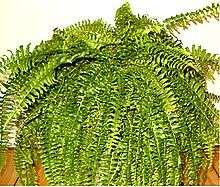Nephrolepis
Nephrolepis is a genus of about 30 species of ferns. It is the only genus in the family Nephrolepidaceae, placed in the suborder Aspleniineae (eupolypods I) of the order Polypodiales in the Pteridophyte Phylogeny Group classification of 2016 (PPG I).[1] (It is placed in the Dryopteridaceae in some other classifications.[2]) The genus is commonly referred to as macho ferns or swordferns.
| Nephrolepis | |
|---|---|
 | |
| Nephrolepis exaltata | |
| Scientific classification | |
| Kingdom: | Plantae |
| Clade: | Tracheophytes |
| Class: | Polypodiopsida |
| Order: | Polypodiales |
| Suborder: | Polypodiineae |
| Family: | Nephrolepidaceae Pic.Serm. |
| Genus: | Nephrolepis Schott, 1834 |
| Species | |
|
See text | |
Phylogeny
The following cladogram for the suborder Polypodiineae (eupolypods I), based on the consensus cladogram in the Pteridophyte Phylogeny Group classification of 2016 (PPG I),[1] shows a likely phylogenetic relationship between Nephrolepidaceae and the other families of the clade.
| Polypodiineae (eupolypods I) |
| ||||||||||||||||||||||||||||||||||||||||||||||||
Selected species
- Nephrolepis biserrata (Sw.) Schott. (syn. Aspidium bisseratum Sw., Aspidium acutum Schkuhr, Nephrolepis acuta (Schkuhr) C. Presl, Polypodium puctulatum Poir)
- Nephrolepis cordifolia (L.) C. Presl (syn. Polypodium cordifolium L., Nephrolepis tuberosa (Bory ex Willd.) C. Presl, Aspidium tuberosum Bory ex Willd.)
- Nephrolepis exaltata (L.) Schott (syn. Polypodium exaltatum L.)
- Nephrolepis falcata
- Nephrolepis multiflora (Roxb.) F.M. Jarret ex C.V. Morton (syn. Davallia multiflora Roxb.)
- Nephrolepis obliterata
- Nephrolepis pectinata (Willd.) Schott (syn. Aspidium pectinatum Willd.)
- Nephrolepis tuberosa
Some species of Nephrolepis are grown as ornamental plants. Nephrolepis exaltata and Nephrolepis obliterata are reported to be good plants for cleaning indoor air.[3]
Some Nephrolepis species may prove to be a good source of new antimicrobial chemicals.[4]
References
- PPG I (2016), "A community-derived classification for extant lycophytes and ferns", Journal of Systematics and Evolution, 54 (6): 563–603, doi:10.1111/jse.12229
- USDA: Nephrolepis; family Dryopteridaceae. . accessed 7 Sept. 2016.
- Kent D. Kobayashi; Andrew J. Kaufman; John Griffis & James McConnell (2007). "Using Houseplants to Clean Indoor Air" (PDF). Cooperative Extension Service, College of Tropical Agriculture and Human Resources University of Hawai'i at Manoa: Ornamentals and Flowers. OF-37.
- Rani D, Khare PB, Dantu PK"In Vitro Antibacterial and Antifungal Properties of Aqueous and Non-Aqueous Frond Extracts of Psilotum nudum, Nephrolepis biserrata and Nephrolepis cordifolia." Indian J Pharm Sci. 2010 Nov;72(6):818-22
Further reading
- Hennequin, S., Hovenkamp, P., Christenhusz, M.J.M. & Schneider, H. (2010) Phylogenetics and biogeography of Nephrolepis – a tale of old settlers and young tramps. Bot. J. Linn. Soc. 164(2): 113–127. doi:10.1111/j.1095-8339.2010.01076.x
- Lorenzi, H. & Souza, M. S. (2001). Plantas Ornamentais no Brasil: arbustivas, herbáceas e trepadeiras. Plantarum ISBN 85-86714-12-7
External links
| Wikimedia Commons has media related to Nephrolepis. |